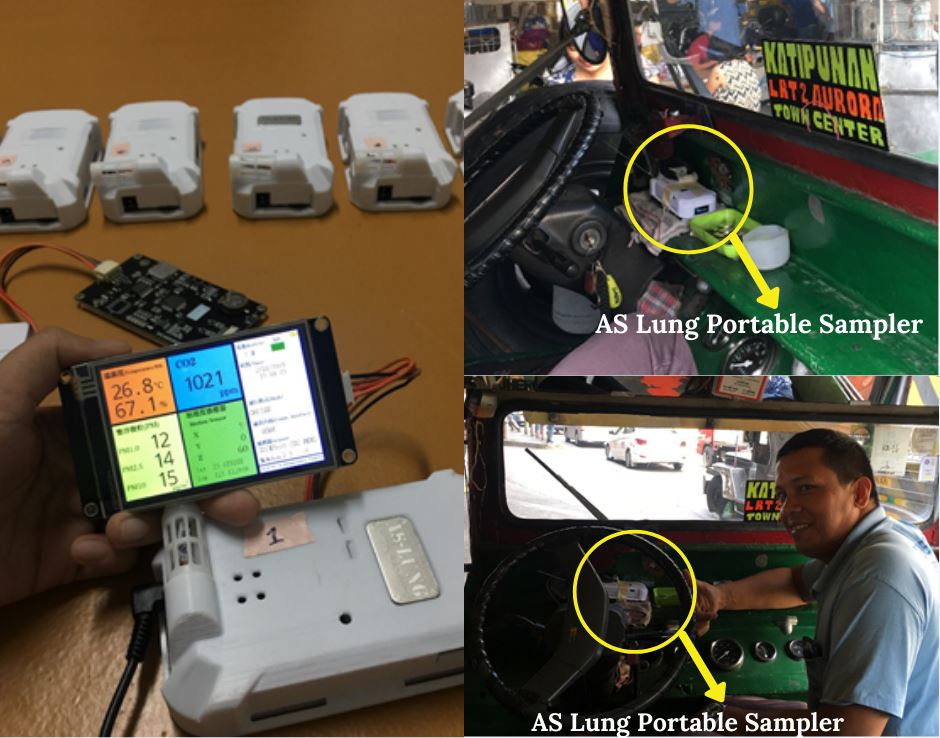Metro Manila, Philippines is one of the megacities in Southeast Asia that has PM2.5 concentrations higher than guideline values, with the public utility jeepney (PUJ) as one of the identified sources contributing to fine particulate pollution in the city. The PUJ is the cheapest and most popular mode of transportation. Jeepney drivers, a high-risk occupational group, ply their routes for 10 to 12 hours a day, exposing them to high levels of particulate pollution. Thus, a series of field measurements were carried out for five weeks from November to December 2018 along the UP Campus – Katipunan jeepney route to characterize the spatial and temporal distribution of fine particulate pollution, and to estimate the personal exposure of the jeepney drivers to PM2.5.
Real-time PM2.5 personal exposure levels of 31 drivers plying a fixed 8 km route were recorded continuously for 10-12 hours each sampling from November 12 to December 15, 2018, yielding a total of 1061 complete circuits. Sampling results showed that the mean PM2.5 exposure concentration for all runs was 38 μg m-3, about a factor of four greater than the mean annual PM2.5 guideline value (10 μg m-3) set by the World Health Organization. Elevated levels of PM2.5 (hotspots) were also identified for the designated route, and these were consistently observed at intersections and across a shopping mall. The AS Lung Portable Samplers were attached to the jeepney dashboard within the driver’s breathing zone. Lower right: With Mr. Joe Ann Mendoza of the Katipunan-KMart Jeepney Operators and Drivers Association (KKJODA)

To ascertain the accuracy of field measurements, the seven portable PM2.5 samplers used in the study were collocated with a Beta Attenuation Monitor (BAM) for 16 days (N = 368, mean number of sampling points), showing strong linear relationship with the BAM for all seven sensors (R2 = 0.83 to 0.85). The seven AS Lung Portable Samplers were set up to take outdoor side-by-side measurements with the Beta Attenuation Monitor (BAM).

The results of this study will provide valuable information on the PM2.5 exposure of this occupational group that is most exposed to particulate pollution, as well as the identification of locations of transport microenvironments that have very high fine particulate pollution. Furthermore, the results of this study will offer quantitative evidence that is much needed by the government’s Public Utility Vehicle Modernization Plan (PUVMP), a policy program that aims to replace old jeepneys with a more eco-friendly version that produces fewer particulate matter emissions.
This study aims to determine and evaluate the physiological parameters of jeepney drivers exposed to high levels of occupational PM2.5 in order to pave way for the understanding of the financial implications of their current state versus the potential state the government sees them in. In order to do this, the PM exposures of jeepney drivers in Metro Manila, specifically in the Katipunan Avenue area were measured. Their corresponding physical outcomes including heart rate, blood pressure, oxygen saturation and peak expiratory flow variability were also measured.
The Resilience Collaboratory runs activities and programs that aim to strengthen the resilience capacities of communities that are exposed to frequent hazards, to address local vulnerabilities, and to support efforts to adapt to disaster risks and climate impacts. The Resilience Collaboratory facilitates collaboration among the core laboratories of the Manila Observatory with a shared goal of delivering useful and usable climate and disaster risk information to the most vulnerable, and initiates transdisciplinary partnerships with various institutions outside academia especially civil society organizations, and the public and private sectors.
For more information about the Resilience Collaboratory, visit the Manila Observatory website.
RELATED STUDIES
Climate Projections 🔗 | Characterizing climate-related and atmospheric hazards, vulnerability and risk across space and time
Health 🔗 | Assessing and Projecting Climate-Related Infectious Diseases in Quezon City
Social Vulnerability 🔗 | From the Skies to the Streets: An Ethnography of Street-based Populations in Metro Manila, Philippines, and Local Knowledge Systems Regarding Environmental Pollution and Climate Disaster Risks
RELATED STORIES
Dr. Cambaliza in the SRI (Sustainability Research & Innovation) Congress 2021
Tackle Air Quality and Human Health with New Thinking and Technologies, 🔗Read More

DR. MARIA OBIMINDA L. CAMBALIZA

MS. MELLIZA T. CRUZ

DR. JAMES BERNARD SIMPAS

DR. JOHN WONG

DR. CHARLOTTE KENDRA GOTANGCO GONZALES

MS. IMEE DELOS REYES

MS. GABRIELLE FRANCES LEUNG

MS. KATRINA ABENOJAR

Mr. Carlos Manalo

MS. PAOLA ANGELA BAÑAGA

Mr. Bernell Go

MS. CHRISTINE LO CHAN

Ms. Grace Betito

Mr. Jarl Tynan Collado

Mr. Jose Gabriel F. Abalos
502 total views
